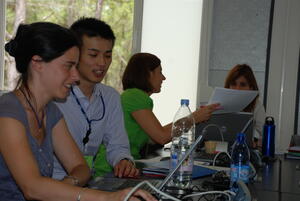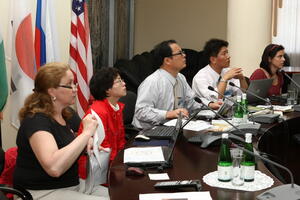The future is a three-letter word
Three letters contain the roadmap for the ITER Project, its timetable, its guideline ... IPS, or the Integrated Project Schedule. It is this schedule by which the construction phase of the project will be managed. The IPS defines the milestones and work packages which are to be undertaken for each of the ITER systems—from huge vessel sectors down to the last bolts. IPS will enable the management team to monitor and report on progress and will facilitate the strategic decision-making process.
But setting up an integrated schedule for a world-spanning enterprise like ITER, with in-kind contributions from seven Members representing 33 nations, is not an easy matter. The conductors for ITER's superconducting toroidal field coils, for example, will be manufactured by China, Korea, Russia, Japan, the US and Europe. In order to get all the loose ends sorted out and tied together, a battalion of professional planners is working on this document, both at ITER Headquarters in Cadarache and in the Domestic Agencies. And although most of the coordination between the various groups is done remotely, it is sometimes necessary to meet in person and talk live.
The most recent Planning & Scheduling Working Group was hosted by the Russian Domestic Agency at the Kurchatov Institute in Moscow from 30 June to 1 July. "The purpose of the meeting was to discuss and finalize with the Domestic Agencies the conventions for schedule structure, milestone content, activity definition, and risk factors," explains Working Group Chairman Steve Gilligan. In a separate session, the first draft IPS for ITER's toroidal and poloidal coils, vacuum vessel, cryostat, thermal shield and cryogenic systems was recorded, and actions listed to finalize each of these IPS elements.
Another round of IPS meetings is currently being held in Cadarache. From 20-31 July, no less then 78 working sessions have been set up between the schedulers from the ITER Organization and the Domestic Agencies to collaboratively review, amend and agree on each element of the IPS. "These meetings will continue the excellent cooperation between the ITER Organization and Domestic Agency Planning & Scheduling groups and will ensure that any schedule issues are identified and resolved as quickly as possible," says Steve.
The timeline to completion of the IPS is very tight; a complete first draft will be published at the end of July, and a second draft at the end of August. It is intended that the IPS will then be published for final approval at the ITER Organization-Domestic Agency meeting in Chengdu, China in September. This is a very challenging timeline which will succeed with the full cooperation and action of all the stakeholders.



